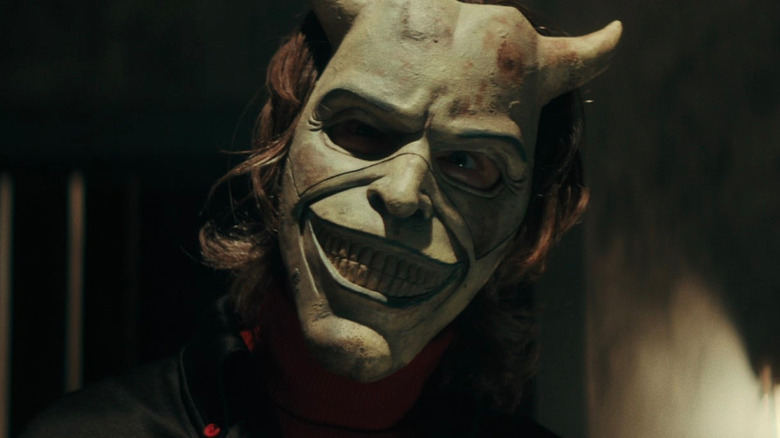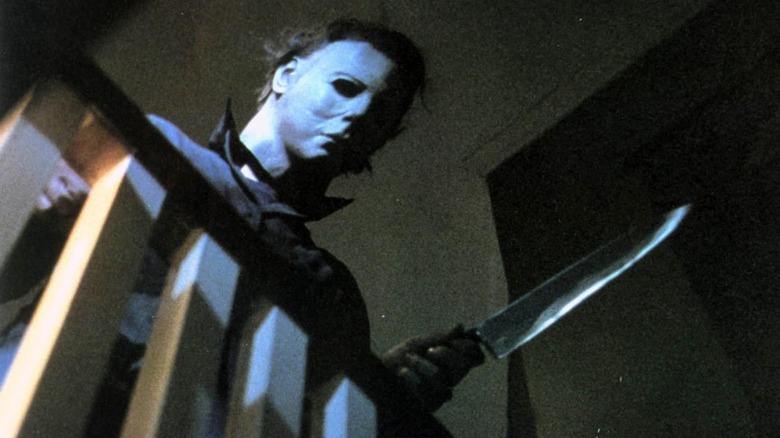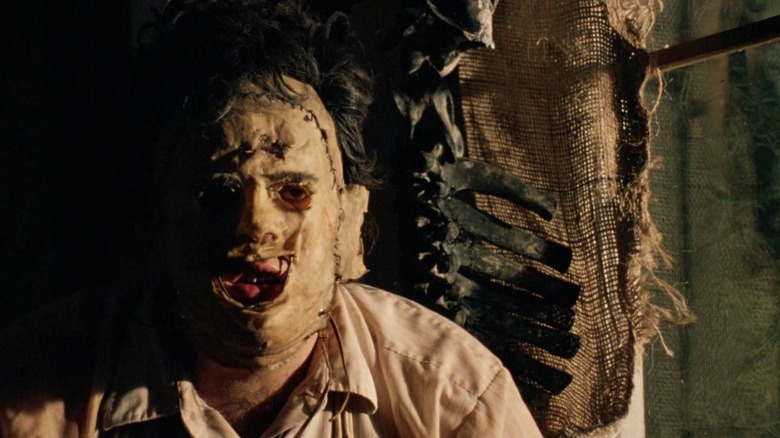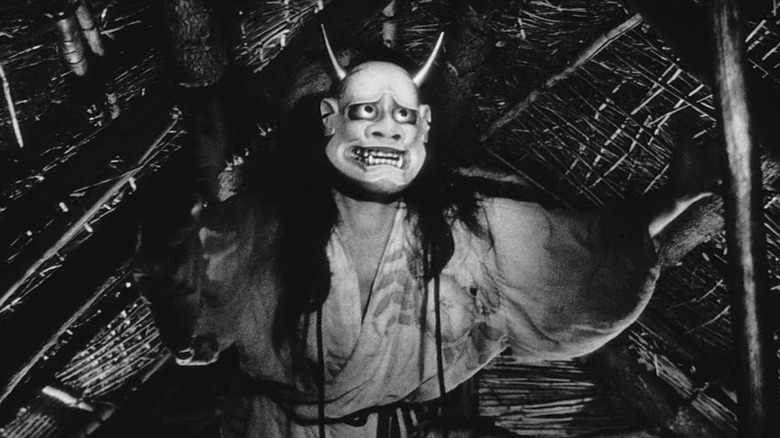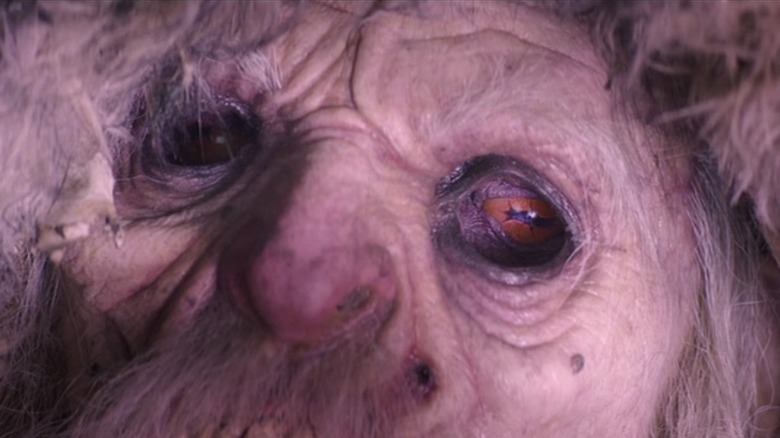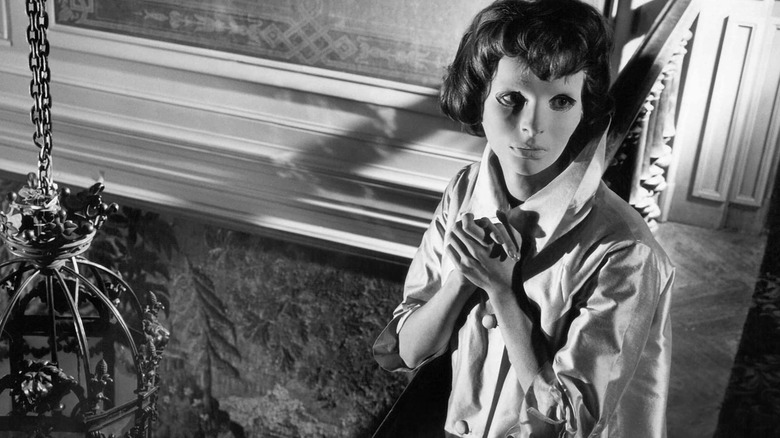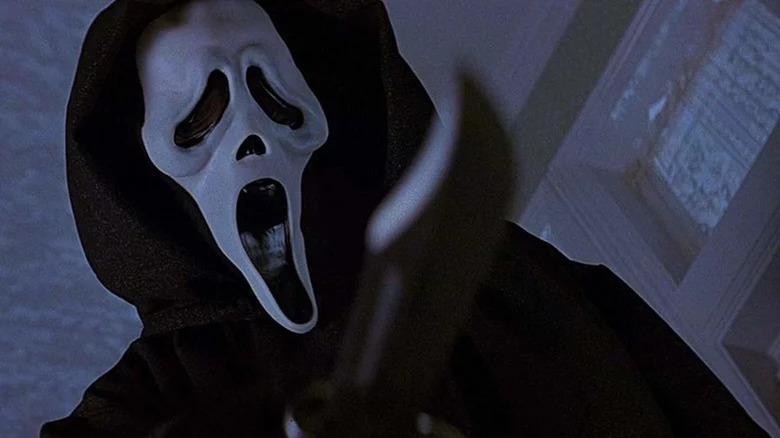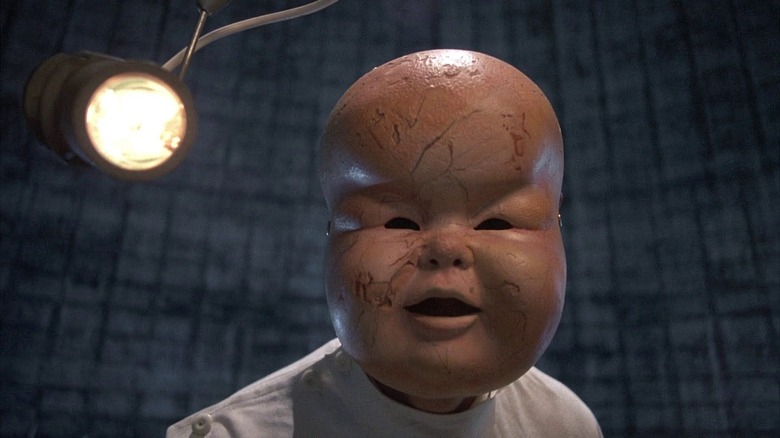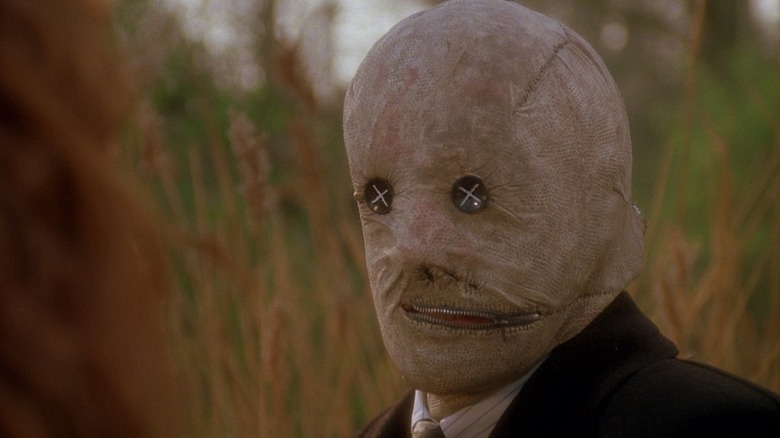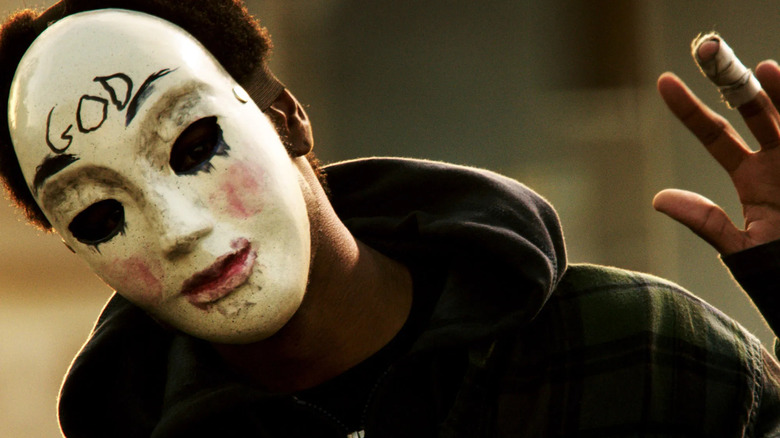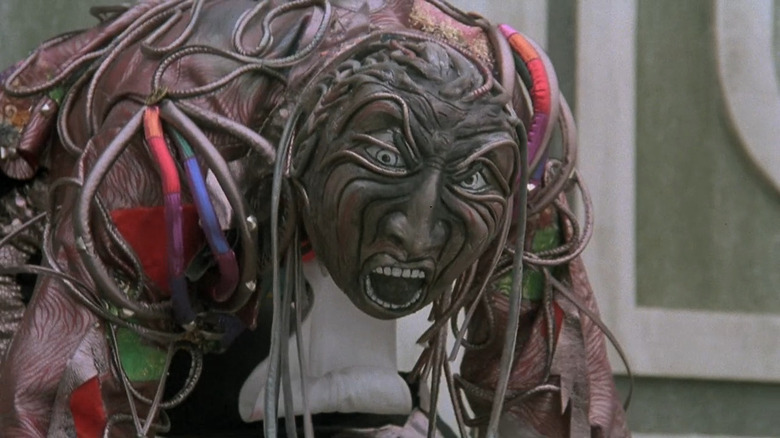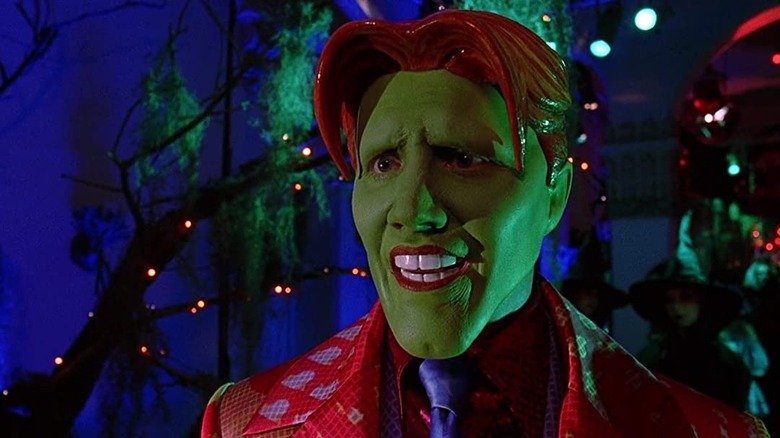The Creepiest Horror Movie Masks Ever
Where would a movie serial killer be without a good mask?
Well, prison. They'd probably be in prison. Because they would have been easily identified and apprehended. They also wouldn't have a reputation for being so horrifying and creepy had their intended victims been able to see their faces. A mask makes a killer inscrutable, mysterious, inhuman. With a mask on, a killer becomes something altogether more horrifying: A being that cannot be reasoned with. If a killer displays emotions, they suddenly become relatable and recognizable. They can be talked to and, potentially, talked out of their mad quest to cause death and suffering. With a mask, there is no thought or reason. There is merely a facsimile of a human face that will, expression fixed, move forward with a blade, cutting into humans as a matter of course. They now live to kill. That's chilling.
In honor of the creepy grinning demon mask that Ethan Hawke will be seen wearing in Scott Derrickson's upcoming horror film "The Black Phone," out in theaters on June 24, 2022, here is a list of eleven of the creepiest facial appliances seen in feature films. Happy nightmares, kids.
Michael Myers' Captain Kirk mask
It's a well-known piece of trivia that Michael Myers' now-infamous plain white mask seen in John Carpenter's 1978 slasher classic "Halloween" was constructed from a Captain Kirk mask from "Star Trek." The hair on the mask was teased back, the eyeholes were cut to be a little larger, and it was spray painted white. Carpenter and cinematographer Dean Cundey were also careful to light the mask from angles wherein the actor's eyes would be kept in shadow, giving Michael Myers an even more ethereal look (when you can see Michael's eyes, the effect is somewhat lost).
Over the course of eleven (to date) "Halloween" sequels and remakes, the mask would change slightly, never quite matching the eerie, blank, black-eyed stare of the original. Carpenter has said that Myers was meant to be "semi-supernatural." Perhaps born of humankind, but inexplicably unkillable, brought to a new plane of existence by his indifferent evil. Robbing Michael of his face was a canny move that highlighted his inhumanness.
Leatherface's mask of human skin
Based loosely on the real-world killings of Ed Gein, Tobe Hooper's 1974 classic "The Texas Chain Saw Massacre" is oily, fetid, and unpleasant to this day. It has lost none of its power to shock and disgust, despite decades of sub-par sequels attempting (very hard) to tarnish its legacy. In the film, a group of average twentysomethings wanders from their van into the most remote, rural areas of Texas to find a family of murderers, reduced to insanity and cannibalism by desperate economic times. "Texas" stands as a warning against American neglect: A blind eye to the country's smallest communities is enough to create generations of unseen cannibals.
A member of this family is nicknamed Leatherface for his mask, sewn together from the skin of his victims. Leatherface is mentally disadvantaged and seems to have no view of the world beyond that of his profession: a butcher. Audiences never learn why Leatherface wears his mask, other than he is also a craftsperson who likes making things out of his chosen medium: Human bodies.
Leatherface's mask is the only one on this list you can probably smell through the screen.
The demon mask from Onibaba
One of the scariest films of the 1960s, Kaneto Shindo's "Onibaba" is a whispery, menacing nightmare of greed, lust, and — perhaps — demons. Sometime in the mid-fourteenth century, a pair of women (Nobuko Otowa and Jitsuko Yoshimura) live in a large field of seven-foot-high reeds that never stop waving in the wind. The two women have come to make a living by luring rogue samurai to their deaths by luring them to an unseen pit in their field. They then strip the dead samurai of their armor and sell it. Their murderous idyll is interrupted by two samurai they cannot lure: One, a younger man who gruffly falls in love with the younger woman, and an eerie masked man — wearing the mask of a demon — who wears his mask to hide how handsome he is. Or perhaps the mask itself is cursed.
The sweaty, panicked fear of "Onibaba" is prevalent throughout, and that mask carries with it a great deal of fearful power. When we see what's under the mask, and what happens next, we are trapped in the film's skillful thicket of terror.
The weird Santa mask worn by the Krampus
Michael Dougherty's 2015 Christmas horror/comedy "Krampus" is a wicked little delight, suitable for viewing every holiday season. In a world run over by holiday greed and resentment, a young child finds he may not believe in Santa Claus anymore. It may be the boy's lack of belief that attracts the holiday demon Krampus to his home. With his block mysteriously empty of neighbors, the boy and his family (including Toni Collette and Adam Scott) will have to defend their home from a nine-foot-tall goat demon with a Santa cloak and a bag of toys. The toys, however, are monsters who aim to eat children. Krampus itself is some sort of goat (in the above picture, its goatlike eyes can be seen) who wears a Leatherface-like mask of human skin. Did the Krampus skin Santa Claus? And what does its real face look like?
Krampus — the folkloric creature — has come to infiltrate the more ironic corners of popular culture, regularly appearing on cynical t-shirts and the occasional board game. Dougherty's film might be the pinnacle of Krampus obsession.
Christiane's mask in Eyes Without a Face
Geroge Franju's 1960 horror melodrama "Eyes Without a Face" is a grandly rococo affair replete with more ennui and quiet suffering than outright horror. Its tone doesn't change the fact that the young Christiane (Edith Scob) — silent in silk pajamas — wanders through her palatial home looking very much like a mannequin, wearing an expressionless mask that might be confused for a real face upon first glance. Christiane, we learn, had her face disfigured in a car accident some time ago, and her father (Pierre Brasseur) has been kidnapping women to steal their facial skin and graft it onto Christiane. As he has not yet perfected the procedure, Christiane wears a mask when each attempt inevitably goes awry.
The florid interiors of "Eyes Without a Face" give the film a soap opera feeling while the "hidden daughter" plot gives it the ring of a fairy tale. It's a terrifying film, yet poised. It's a horror film for the classy.
Fun World's Fantastic Faces: Peanut-Eyed Ghost
The killer in Wes Craven's 1996 film "Scream" — now colloquially referred to as Ghostface — was wearing a costume that was actually available at Halloween stores at least five years prior to the film's release. Belonging to a company called Fun World, the mask belonged to a series of costumes called "Fantastic Faces" which included smiling faces, a jolly face, and the elongated "sad" ghost face seen in "Scream," originally called merely "Peanut-Eyed Ghost."
It was its low-fi, off-the-rack look that made the Ghostface costume so scary. Like the killer wearing it was in such a hurry to commit mayhem that they only had time to swing by the drugstore on the way to the crime scene. That it was so commonly accessed also added to the "Scream" whodunnit story, allowing anyone to be the potential killer. Had Ghostface been wearing a specially constructed mask, it would imply far too much focus. Ghostface kills on a whim, and the costume — only $15.99! — signals their indifference to human life.
Jack Lint's baby mask in Brazil
In Terry Gilliam's Kafkaesque 1985 dystopian sci-fi film "Brazil," the protagonist (Jonathan Pryce) finds himself attempting to fight his way out of a bureaucracy that has long since left human lives in the dust. This is a world where a human being can be kidnapped and disappeared because of a minor clerical error, and paperwork comes to life and eats people alive. The ending of "Brazil" is notoriously bleak, and Gilliam fought hard to have it retained after the studio insisted on something more upbeat.
The bleak ending in question came after the Pryce character altered death records to end the government's pursuit of the woman she had fallen in love with (played by Kim Greist). For his trouble, he was apprehended and was strapped into a chair to be tortured for information by, it turns out, one of his only friends Jack Lint (Michael Palin). The mask that the torturers wear are large, puffy baby masks, cracked and stained after years of use. No one wants to be tortured, but having that terrifying baby face staring at you while it happens could only make things worse.
Curtis' mask from Nightbreed
One of only three feature films directed by the masterful Clive Barker, 1990's "Nightbreed," based on the novel "Cabal," is possessed of mythology too large for one feature film. "Nightbreed" takes place in a world where monsters exist; people who are crossed with animals, who have supernatural powers, who transform in the sunlight. The monsters live in a subterranean wonderland called Midian in order to hide out from the humans that would persecute them. A man named Boone (Craig Sheffer) finds that he might have secretly been a monster his whole life, and has to learn to adapt to his new identity.
Meanwhile, a very human monster is stalking the film's periphery in the form of Curtis, a serial killer in a button-eyed mask who murders "filthy" people he hates. Curtis is, in fact, Dr. Phillip Decker, Boone's shrink. When Dr. Decker learns of the existence of monsters, he goes a little mad and elects to kill them as well. Dr. Decker is played by David Cronenberg, who gives a stirring and chilling performance from under that weird, unsettling, button-eyed mask.
The various masks from the Purge movies
Directly inspired by the "Star Trek" episode "Return of the Archons" — which featured a planet emotionless being who, when the clock strikes the Red Hour, proceeds to riot, loot, make out, and commit crimes — "The Purge" movies are set in a near-future when one night a year, almost all crimes are legal, including murder. The idea is, if you have a night to eff up the world, you'll be on your best behavior the other 364. While the 2013 original, directed by James DeMonaco, is a slapped-together affair (it quickly devolves into a boilerplate home invasion flick), the premise was strong enough to warrant four sequels which increasingly explored the political underpinnings of a world that would instigate a Purge for its citizens (rich white people trek into poor Black neighborhoods carrying guns, an image that is now far too familiar). "The Purge: Election Year" is one of the best horror films of its decade.
One of the traditions of The Purge is that citizens don scary masks for their murder parties ... and damn, those masks are scary. It's like a dark mirror to West Hollywood's Halloween parade. The first "The Purge" features blank smiling faces. "Anarchy" featured scuffed chorus masks inscribed with "God," and "Election Year" featured the founding fathers. Pretty damning stuff.
The Wheelers
Readers of a certain age likely shared the nightmarish experience of seeing Walter Murch's "Return to Oz," a 1986 follow-up to "The Wizard of Oz," and being mildly traumatized by the sight of the Wheelers. In "Return to Oz," Dorothy (Fairuza Balk) finds herself back in the magical land after a severe cataclysm has undone its magic. The citizens are all statues, the buildings are crumbling, and the Yellow Brick Road has been gouged apart. Infesting the broken cities like rats are Wheelers, human beings with wheels for hands and feet, and terrifying masks on the tops of their heads, giving their heads an eerie, animal quality. At a moment's notice, a Wheeler might round a corner screaming, its head bowed, its mask eyes targeting you.
The Wheelers became less threatening when they raised their heads and Dorothy could see their human faces underneath. But then, it only highlighted their oddness. The Wheelers were pretty horrible all around.
Tim Avery as The Mask
One of the worst films of 2005, Lawrence Guterman's "Son of the Mask" was a way-too-late sequel to the 1994 hit that helped put Jim Carrey on the map. Sans Carrey, "Son" is about the titular mask floating into the possession of Tim Avery (Jamie Kennedy), an animator with a crisis of creativity. As in the 1994 film, when Tim puts on the magical mask, he is possessed by a spirit of mischief (a part of the Norse god Loki) and becomes a green-faced, indestructible human cartoon. Unlike Carrey's round-headed trickster, however, Tim becomes a big-chinned, plastic-haired weirdo who looks too scary to be fun and too doofy to be terrifying. It's simply a bad design.
The plot is equally creepy, as Tim sires a child while wearing the mask, giving his baby cartoon powers. Evil, mischief-making CGI monster baby is no fun, and is certainly scarier than anything on the above list. Despite the presence of Alan Cumming and Bob Hoskins as Loki and Odin respectively, "Son of the Mask" remains unappealing through and through.
